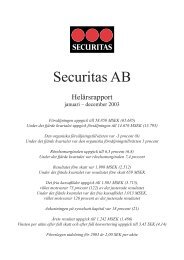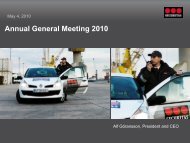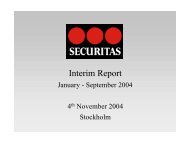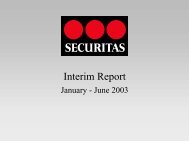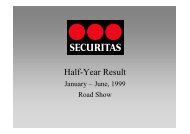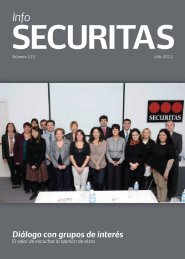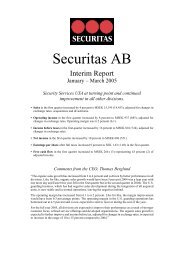Securitas AB Annual Report 2005
Securitas AB Annual Report 2005
Securitas AB Annual Report 2005
You also want an ePaper? Increase the reach of your titles
YUMPU automatically turns print PDFs into web optimized ePapers that Google loves.
Notes and comments to the consolidated fi nancial statements<br />
Tangible fi xed assets (IAS 16 and IAS 36)<br />
Tangible fi xed assets are recognized at cost and subsequently carried at cost less<br />
accumulated depreciation according to plan and any accumulated impairment losses.<br />
Depreciation according to plan is based on historical acquisition values and the<br />
useful life of the asset.<br />
Linear depreciation is used for all asset classes, as follows:<br />
Machinery and equipment 10–25 percent<br />
Buildings and land improvements 1.5–4 percent<br />
Land 0 percent<br />
Impairment (IAS 36)<br />
Assets that have an indefi nite useful life are not subject to amortization and are<br />
tested annually for impairment. Assets that are subject to amortization are reviewed<br />
for impairment whenever events or changes in circumstances indicate that<br />
the carrying amount may not be recoverable. An impairment loss is recognized in<br />
the amount by which the asset’s carrying amount exceeds its recoverable amount.<br />
The recoverable amount is the higher of an asset’s fair value less costs to sell and<br />
value in use. Value in use is measured as expected future discounted cash fl ows.<br />
The calculation of value in use necessitates that a number of assumptions and<br />
estimates are made. The main assumptions concern the organic sales growth, the<br />
development of the operating margin and the necessary operating capital employed<br />
requirement as well as the relevant WACC-rate used to discount future cash fl ows.<br />
For the purposes of impairment testing, assets are grouped at the lowest levels for<br />
which there are separately identifi able cash fl ows (cash-generating units).<br />
Previously recognized impairment losses, with the exception of impairment<br />
losses related to goodwill, are reversed only if a change has occurred regarding the<br />
assumptions that formed the basis for determining the recoverable value when the<br />
impairment loss was recognized. If this is the case a reversal of the impairment<br />
loss is carried out in order to increase the book value of the impaired asset to its<br />
recoverable value. A reversal of a previous impairment loss is only recognized to<br />
the extent that the new book value does not exceed what should have been the<br />
book value (after depreciation and amortization) if the impairment loss had not<br />
been recognized in the fi rst place. Impairment losses related to goodwill are never<br />
reversed.<br />
Leasing contracts (IAS 17)<br />
When a leasing contract means that the Group, as the lessee, essentially receives<br />
the economic benefi ts and bears the economic risk associated with the leased asset –<br />
termed fi nance leases – the asset is accounted as a fi xed asset in the consolidated<br />
balance sheet. The net present value of the corresponding obligation to pay leasing<br />
fees in the future is accounted as a liability. In the consolidated statement of income,<br />
leasing payments are divided between depreciation and interest. The Group<br />
has no signifi cant fi nance leases where it is the lessor.<br />
Operational leases, where the Group is the lessee, are accounted in the statement<br />
of income as an operating expense. In cases where the Group is the lessor,<br />
revenue is accounted as sales in the period the lease relates to. Depreciation is<br />
accounted under operating income.<br />
Accounts receivable<br />
Accounts receivable are accounted net after provisions for probable bad debt.<br />
Probable and recognized bad debt losses are included in the line Production<br />
e xpenses in the statement of income. Payments received in advance are accounted<br />
under Other current liabilities.<br />
Inventories (IAS 2)<br />
Inventories are valued at the lower of cost and net realizable value. Cost is determined<br />
according to the fi rst-in, fi rst-out principle. The cost of fi nished goods and<br />
work in progress comprises of material, direct labour and other direct costs. Net<br />
realizable value is the estimated selling price in the ordinary course of business,<br />
less applicable variable selling expenses. The necessary deductions for obsolescence<br />
are made.<br />
Financial Instruments: Recognition and Measurement<br />
(IAS 39 1 ) – adopted from January 1, <strong>2005</strong><br />
A fi nancial instrument is any contract that gives rise to a fi nancial asset of one entity<br />
and a fi nancial liability or equity instrument of another entity. The defi nition of<br />
fi nancial instruments thus include equity instruments of another entity but also for<br />
example contractual rights to receive cash such as accounts receivable.<br />
Financial instruments are recorded initially at fair value with the subsequent measurement<br />
depending on the designation of the instrument.<br />
1 Refers to IAS 39 in its current version as adopted by the European Union.<br />
The Group designates its fi nancial instruments in the following categories:<br />
■ Financial assets or fi nancial liabilities at fair value through profi t or loss<br />
(including derivatives not designated as hedging instruments),<br />
■ Loans and receivables,<br />
■ Held-to-maturity investments,<br />
■ Available-for-sale fi nancial assets,<br />
■ Financial liabilities designated for hedging,<br />
■ Other fi nancial liabilities and<br />
■ Derivatives designated for hedging.<br />
The designation depends on the purpose for which the fi nancial instrument is<br />
acquired. Management determines the designation of its fi nancial instruments<br />
at initial recognition and re-evaluates this designation at each reporting date.<br />
Financial assets or fi nancial liabilities at fair value through profi t or loss<br />
Financial assets at fair value through profi t or loss have two sub-categories: fi nancial<br />
assets held for trading, and those designated at fair value through profi t or loss<br />
at inception. A fi nancial asset is classifi ed in this category if acquired principally<br />
for the purpose of selling in the short term or if so designated by management. Fair<br />
value derivative assets are also categorised as held for trading unless they qualify<br />
for hedge accounting. Assets in this category are classifi ed as current assets if they<br />
are either held for trading or are expected to be realised within 12 months of the<br />
balance sheet date. Financial liabilities at fair value are trading securities with<br />
negative fair value; normally derivative liabilities unless they qualify for hedge<br />
accounting.<br />
Loans and receivables<br />
Loans and receivables are non-derivative fi nancial assets with fi xed or determinable<br />
payments that are not quoted in an active market. They arise when the Group<br />
provides money, goods or services directly to a debtor with no intention of trading<br />
the receivable. They are included in current assets, except for maturities later than<br />
12 months after the balance sheet date.<br />
Held-to-maturity investments<br />
Held-to-maturity investments are non-derivative fi nancial assets with fi xed or<br />
determinable payments and fi xed maturities that the Group’s management has the<br />
positive intention and ability to hold to maturity.<br />
Available-for-sale fi nancial assets<br />
Available-for-sale fi nancial assets are non-derivatives that are either designated in<br />
this category or not classifi ed in any of the other categories. They are included in<br />
non-current assets unless management intends to dispose of the investment within<br />
12 months of the balance sheet date.<br />
Financial liabilities designated for hedging<br />
Financial liabilities designated for hedging are liabilities that are hedged instruments<br />
in a hedge relationship qualifying for hedge accounting. The hedging instrument<br />
is normally a derivative included in the category derivatives designated for<br />
hedging. They are included in non-current liabilities except for maturities later<br />
than 12 months from the balance sheet date.<br />
Other fi nancial liabilities<br />
Other fi nancial liabilities are any fi nancial liabilities that are not included under<br />
fi nancial liabilities designated for hedging. They are included in non-current<br />
liabilities except for maturities later than 12 months from the balance sheet date.<br />
Derivatives designated for hedging<br />
Derivatives designated for hedging are instruments designated as hedging instruments<br />
and qualifying for hedge accounting. The Group normally only enters into<br />
derivative contracts when they qualify for hedge accounting.<br />
Most of the Group’s current assets are loans and receivables (including<br />
accounts receivable and most other current receivables). Financial assets or fi nancial<br />
liabilities at fair value through profi t or loss, held-to-maturity investments and<br />
available-for-sale fi nancial assets are normally categories in which the Group has<br />
no or very limited positions in. Financial liabilities designated for hedging<br />
includes both long-term and short-term loans designated as hedged instruments<br />
and hedged effectively via derivatives designated for hedging. Other fi nancial liabilities<br />
comprise all other fi nancial liabilities including such items as accounts<br />
payable and other current liabilities and also any long-term and short-term loans<br />
not included in fi nancial liabilities designated for hedging.<br />
82 SECURITAS <strong>2005</strong>




